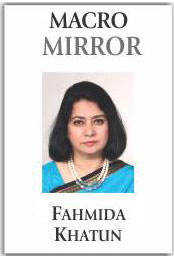Recently, the Centre for Policy Dialogue and Manusher Jonno Foundation conducted a comprehensive study that assessed both women and men’s involvement in various activities. The objective was to understand the time use pattern of people and to estimate the value of women’s unaccounted work.
Published in The Daily Star on Tuesday, 17 November 2015.
MACRO MIRROR
Counting a woman’s worth
Dr Fahmida Khatun
More than anywhere else in the world, in Bangladesh we are probably very curious about other peoples’ personal lives. We try to gather as much information as we can when we meet people. Then we situate them accordingly within our mental frame and talk about them afterwards. One of the first questions directed towards women when we meet them for the first time is what do they do, meaning if they work or not. Of course, this is not to know whether they work at home or not. Women will work at home. That is normal and taken for granted. They will cook food, clean dishes, wash clothes, do groceries, rear children, care for the elders and manage the household. We are not interested to know that. We want to know if she works at an office or has a business that gives her an income. A common response from women to this ‘unsolicited’ question is ‘no, I don’t do anything’. And when they reply, I have noticed, among many, a look of embarrassment. Of course a few smarter ones have started to recognise themselves as ‘homemakers’.
This is not only a reflection of the mentality of both the questioner and the respondent, but of the society as a whole. There was a time when women’s work outside their home was not widely accepted or looked at positively in our society. Over time, this has changed significantly, among both women themselves and their families. This is a positive shift contributing to personal and social progress. In the national statistics, this is reflected through higher female labour force participation rates. From a mere 4 percent in 1974, female labour force participation rate has increased to 36 percent in 2010. But a majority of them — over 90 percent — work in the informal sector, with low and unpredictable income. As a result, their contribution to the economy is much lower than that of men.
In fact, despite an increase in the total working age of the female population, women’s contribution to GDP is only about 30 percent. This is not only due to their greater involvement in the less productive informal sector but also because they are engaged mostly in unpaid activities within the household which are not counted in the traditional measure of GDP. This is a serious shortcoming of the system of national accounts worldwide. This is the cause of women’s weakened position in the family and society. In many families, without an income, a woman has no worth. They remain as an object of neglect, insult and torture. But are they really worthless?
Recently, the Centre for Policy Dialogue and Manusher Jonno Foundation conducted a comprehensive study that assessed both women and men’s involvement in various activities. The objective was to understand the time use pattern of people and to estimate the value of women’s unaccounted work. Women and men in 5,670 households across 64 districts of Bangladesh were interviewed through a detailed questionnaire. A total of 8,320 female and 5,320 male aged 15 years and above from these households took part in the survey.
Findings of the study are revealing. It shows that, on average, time spent by a female member of a household on unpaid work is about three times higher than that of a male household member. And the value of women’s unpaid household work is equivalent to 76.8 – 87.2 percent of the GDP. The price of women’s unpaid work is 2.5 to 2.9 times more than their income from paid work.
Inclusion of this value which remains outside the sphere of traditional GDP accounting will surely increase women’s contribution to GDP substantially. It would increase the size of the GDP as well. This is one aspect of women’s work. The other issue is to increase their participation in the job market and give them opportunities to earn. Their participation in paid work is constrained due to their multifarious roles within their families. Even those who are engaged in paid jobs, do part-time and low paid jobs in low productive sectors such as agriculture. The aforementioned study also found that not all women are interested in being involved in paid jobs. Only one-fourth of those who are not in any job at present expressed their willingness to work outside home. It’s not only because their families disapprove of their work, but they themselves prefer to give time to their families. Therefore, many of those who are looking for work would like to work as a part-timer so that they can perform their household responsibilities as well.
Two inferences emanate from this. First, women’s decision to take part in paid work is still influenced by family members who are prejudiced against women’s participation in the workforce. Second, the employment pattern of women will take some time to change. Even if they are offered full-time employment many women have to forgo the opportunity as they are overburdened with household chores. Thus the deep-rooted attitude about women’s role has to be changed. Policymakers have to recognise women’s unaccounted work through incorporating those into the national accounts. The final objective, however, is to bring more women into the labour market for paid jobs — a job that will give her security, status and self-esteem; a job that would increase GDP many folds and make growth inclusive.
The writer is Research Director at the Centre for Policy Dialogue, currently a Visiting Scholar at the Centre for Study of Science, Technology & Policy, India.




